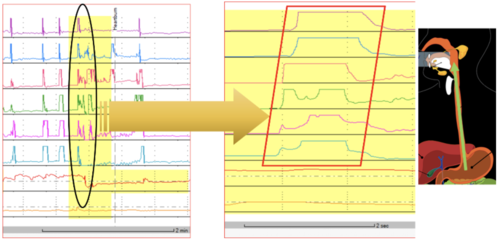The journey from diagnosis to treatment should be straightforward, with as little burden on the patient as possible. Unfortunately, this is not always the case.
It can often take around a year for gastroenterology outpatients to get the correct testing, diagnosis and consequently the right treatment for their symptoms – and often at expense to themselves in terms of money, time and energy.
The Journey to Treatment
Typically, a patient experiencing gastrointestinal issues will go to their GP for a diagnosis and treatment, the GP will then refer them to a hospital for testing to identify the cause of their symptoms. Often, hospitals simply don’t have the right gastroenterology testing expertise; in these cases, the patient has to have an additional appointment with a gastroenterologist who has has the requisite training and who can access crucial tests such as high resolution oesophageal manometry and pH-impedance reflux monitoring. On top of this, not all hospitals offer gastroenterology services which then requires patients to possibly travel long distances to get testing resulting in costs to them in terms of time, money and lost income.
Once the patient has had their appointment with a gastroenterologist, the test results need to be sent to the consultant – which takes on average 3 months. There then follows another appointment with the consultant and finally a treatment plan before the patient is discharged back to their GP. If the patient does not respond to the treatment, they will then have to return to the gastroenterologist or consultant – repeating the cycle until the patient is successfully treated, or gets frustrated and gives up!

The current path is too often slow, expensive, and deeply frustrating for everyone involved – but through innovation, the quality of care and the overall patient experience can be greatly improved and waiting times drastically reduced.
Case Study: Stockport
An NHS case study conducted in Stockport shows how a more streamlined approach can work to eliminate unnecessary referrals, cutting down on waiting times and costs whilst improving the quality of care for patients. Using a phone-based consultant service specialising in gastroenterology, the pilot study found that 48% of calls through this service avoided unnecessary referrals – cutting out several steps of the typical process. On top of that ‘Referral to Treatment Time (RTT)’ dropped from 13.7 weeks to 8.8 weeks – a great improvement directly caused by faster access to appointments and referrals.
Mobile GI physiology testing can reduce RTTs even further – drastically lifting the burden on patients and improving the quality of care provided by clinicians and CCGs.
A Mobile Approach
With mobile testing, the typical process is simplified, and both costs and waiting times are greatly decreased. In this scenario, the patient visits their GP and presents their symptoms; they can then get GI physiology testing at their GP surgery. Based on those results, the GP can make a decision about treatment or continue additional testing if needed. The result is faster testing, diagnosis and treatment, while the patient feels they are receiving a great service where their health is made a priority by healthcare professionals.
GI Cognition’s mobile GI physiology service offers this streamlined pathway while delivering quick, accurate results benefiting everyone involved – from patients to clinicians to CCGs.










